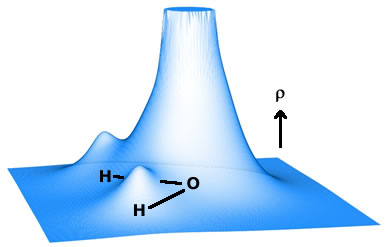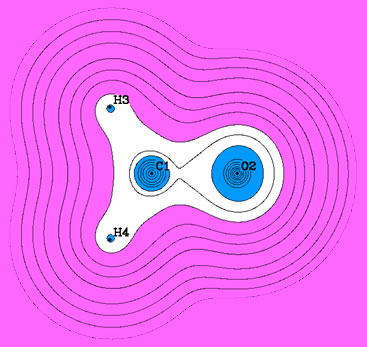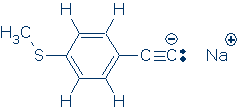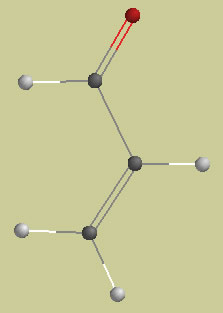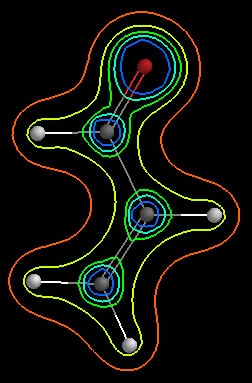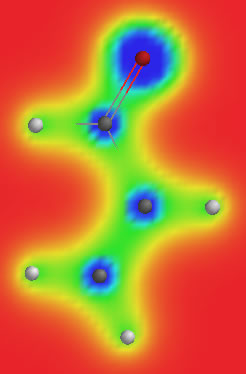
|

|
Universal
features of molecular electron density clouds
The detailed features of an electron density cloud are unique to each atom and molecule. However, all clouds share a few general features, and some of these are worth knowing about.
r (rho) rises as we move "inward" (towards any nucleus) The following graph shows r (rho) at different points in the molecular plane of H2O. As you can see, r (rho) (which is expressed by surface elevation) rises smoothly from the edge of the graph towards each nucleus. r (rho) does not oscillate except on paths that lead from nucleus to another.
r (rho) obeys electrostatic forces This graph also shows that there is much more electron density in the vicinity of O. Electrostatic attraction moves electron density (negative charge) towards an atomic nucleus (positive charge). The O nucleus carries a much larger charge (+8) than H (+1), so it can attract more electron density. The total amount of electron density around an atom can also be predicted by considering how many electrons should be in the atom's vicinity. Consider KOH. This compound contains two ions, K+ and HO-, but K+ contains more electrons (18, all core) electrons than HO- (10, valence + core). There should be much more electron density around K+ than HO- even though K+ carries a positive charge. (Note: we would We could also have predicted this by looking at nuclear charges: K = +19, O = +8, H = +1.)
Electron density clouds contain 3 zones The following contour graph shows r (rho) in the molecular plane of formaldehyde, H2C=O. I have added colors to the graph so that areas of different electron density/contour shape can be distinguished more easily. (Click on diagram for larger image.) Each nucleus is surrounded by a blue core zone consisting of circular contours. The core zone contains the innermost contours, that is, high electron density. The circular shape of the cores (which is the same shape seen in isolated atoms) suggests that core electron density is controlled by the nucleus' electric field, and not by neighboring atoms. Given that conclusion, it makes sense that the relative amount of electron density in different cores follows the same pattern as the nuclear charges: O(+8) > C(+6) >> H(+1). The cores are surrounded by a single white bonding zone of moderate electron density. Each contour in the bonding zone surrounds two or more nuclei, showing that moderate electron density not only surrounds the high density cores, it also extends into the zone between bonded atoms. Apparently, covalent bonding moves electron density around so that it builds up in bonding regions. The bonding zone is surrounded in turn by a single large pink-purple molecular zone of low electron density. Every contour in the molecular zone surrounds all of the atoms in the molecule. This pattern - a small core (of high electron density surrounding each nucleus) surrounded by a bonding zone (of moderate electron density that encloses bonding regions) surrounded in turn by molecular contours (of low electron density) - is a characteristic feature of electron density clouds.
Review problems #1. Where does the highest electron density appear in a molecule? A) at a nucleus, B) between bonded nuclei, C) near negatively charged atoms.
#2. Where do you expect to find the highest electron density in this salt? (Hint: find out the atomic number of each atom)
#3. Acrolein, H2C=CHCH=O, is a planar molecule. A ball-and-wire model is shown below (left), along with two different style graphs of the electron density in the molecular plane (click on graphs for larger images).
a. Which contour in the center graph corresponds to the highest electron density? Which contour corresponds to the lowest electron density? (Specify colors) b. Which zone(s) in the graph on the right might represent core, bonding, and molecular zones. (Specify colors) |
